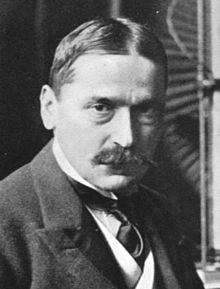Mihajlo Pupin | |
|---|---|
| Михајло Пупин | |
 Pupin, c. 1890 | |
| Born | October 4, 1858 |
| Died | March 12, 1935 (aged 76) New York City, U.S. |
| Resting place | Woodlawn Cemetery, New York City |
| Citizenship | Austria (1858–1883) United States (1883–1935) |
| Alma mater | |
| Known for | Pupin coils |
| Spouse |
Sarah Catharine Jackson
(m. 1888) |
| Children | 1 |
| Awards |
|
| Scientific career | |
| Fields | Physics |
| Institutions | Columbia University |
| Doctoral advisor | Hermann von Helmholtz |
| Other academic advisors | John Tyndall |
| Notable students | Edwin Howard Armstrong |
| Signature | |
Mihajlo Idvorski Pupin (Serbian Cyrillic: Михајло Идворски Пупин, pronounced [miˈxǎjlo ˈîdʋoɾski ˈpǔpin]; October 4, 1858[3][4] – March 12, 1935), also known as Michael Pupin, was a Serbian-American electrical engineer, physicist and inventor.[5]
Pupin is best known for his numerous patents, including a means of greatly extending the range of long-distance telephone communication by placing loading coils (of wire) at predetermined intervals along the transmitting wire (known as "pupinization"). Pupin was a founding member of National Advisory Committee for Aeronautics (NACA) on 3 March 1915, which later became NASA,[6] and he participated in the founding of American Mathematical Society and American Physical Society.
In 1924, he won a Pulitzer Prize for his autobiography. Pupin was elected president or vice-president of the highest scientific and technical institutions, such as the American Institute of Electrical Engineers, the New York Academy of Sciences, the Radio Institute of America, and the American Association for the Advancement of Science. He was also an honorary consul of Serbia in the United States from 1912 to 1920 and played a role in determining the borders of newly formed Kingdom of Serbs, Croats and Slovenes.[7][8]
- ^ IEEE Global History Network (2011). "IEEE Edison Medal". IEEE History Center. Retrieved 8 July 2011.
- ^ IEEE Global History Network (2011). "IEEE Medal of Honor". IEEE History Center. Retrieved 8 July 2011.
- ^ Although Pupin's birth year is sometimes given as 1854 (and Serbia and Montenegro issued a postage stamp in 2004 to commemorate the 150th anniversary of his birth), peer-reviewed sources list his birth year as 1858. See:
- Daniel Martin Dumych, "Pupin, Michael Idvorsky (4 Oct. 1858 – 12 Mar. 1935)," American National Biography Online, Oxford University Press, 2005. Accessed 11 March 2008.
- Bergen Davis, "Biographical Memoir of Michael Idvorksy Pupin", National Academy of Sciences of the United States Biographical Memoirs, tenth memoir of volume XIX (1938), pp. 307–323. Accessed 11 March 2008.
- According to Pupin's obituary notice in the New York Times, (14 March 1935, p. 21), he died "in his 77th year." Accessed via ProQuest, 11 March 2008.
- ^ The Tesla Memorial Society tribute webpage, though dedicated to a "150 years" birthday celebration in 2004, includes a photo of Pupin's gravestone showing the dates 4 October 1858 and 12 March 1935. Accessed 9 October 2011.
- ^ "Mihajlo-Pupin".
- ^ "NASA – First Meeting". Nasa.gov. Archived from the original on 8 February 2015. Retrieved 27 December 2012.
- ^ "Пупинови успеси у Сен Жермену". Politika Online. Retrieved 12 September 2019.
- ^ "The role of Michael Pupin in solving of Serbian national question | Request PDF". ResearchGate. Retrieved 12 September 2019.